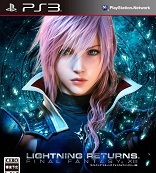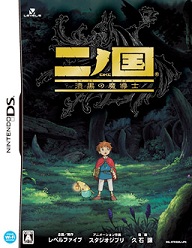Final Fantasy IV (Import Review)
Nintendo DS
Reviewed: 01/07/2007
 Final Fantasy IV DS could have potentially been a cop-out, slapdash remake that added little or nothing to the original game’s legacy. Fortunately, this is one remake that opts to take the high road, enhancing the original game in nearly every aspect while preserving what made it so dang fun. Those unfamiliar with the source material will find a simple, yet powerful, RPG in this tiny cartridge, while those who are veterans of it will find much to discover and little to complain about.
Final Fantasy IV DS could have potentially been a cop-out, slapdash remake that added little or nothing to the original game’s legacy. Fortunately, this is one remake that opts to take the high road, enhancing the original game in nearly every aspect while preserving what made it so dang fun. Those unfamiliar with the source material will find a simple, yet powerful, RPG in this tiny cartridge, while those who are veterans of it will find much to discover and little to complain about.
Final Fantasy IV DS tells a story that has aged well. It stars Cecil, Captain of the Red Wings of Baron, whose conscience is hounded by the brutal acts his king has recently asked him to commit, and subsequent search for atonement. His path eventually takes him towards opposing his own nation, whose Red Wings are plundering crystals from the kingdoms of the land under orders of a mysterious armored man named Golbez. Ten other supporting party members, each with a rather distinct personality and story, will join Cecil throughout his quest. The script while redone, maintains the intent and spirit of the original, with no unnecessary humor or alterations (again note: this review is of the Japanese version). In terms of a future English version, a poorly localized script could potentially be the biggest disappointment in the game, but given the simplicity of the Japanese script and a lack of added, Nomuralike theatrics, hopefuls shouldn’t worry too much. A few new scenes have been added, presumeably to flesh out some of the background and help the upcoming cell phone sequel make a little more sense. These seem disappointingly thrown together, and raise as many questions about the new writing as they answer about the plot, but are fortunately few and minor. Where this DS incarnation’s story really takes off is in its choreography. Each original story sequence is very well directed (and in some cases, voiced), and manages to bring the sprite-hopping of the Super Nintendo era to life. Scenes will play out nearly identical to their original sprite versions, but far more realistically, and the results are engaging, surprisingly powerful, and genuinely fun to watch.
 |
| The perspective for boss battles switches to this over-the-shoulder view. Regular battles remain side-to-side. |
Final Fantasy IV marks the appearance of the original Active Time Battle system, and this DS remake has brought back more of the same, albeit better organized. Don’t be fooled: this is not a “new” take on the ATB system, but rather brings previously hidden factors into visibility, courtesy of the DS’s bottom screen. Battles will play out on the upper screen, while the lower houses character information, current status, and their ATB gauge, as well as helpful information such as a selected command’s element and hit rate. When full, the ATB bar will refill a different color, representing the charge time of the selected attack. When this second bar fills, the attack will be queued into the list of ready attacks (since only one attack will go off at a time), and subsequently executed. A regular hit with a weapon takes a fraction of a second to charge, while a complicated spell will take significantly longer, with simple commands, spells and items falling somewhere in the middle. The addition of the second bar takes away the guesswork of timing, and really helps the player to plan their attacks more efficiently. This improved interface augments an already strong battle system, and the added difficulty and altered boss strategies will have even veteran Final Fantasy IV players feeling like this is a new game altogether.
Decant Abilities, however, account for the largest modification to the game’s battle system. They enable players to add new skills or abilities to their characters. These skills include those held by other characters, such as “Sing” or “Kick,” and all new passive abilities, such as “Phoenix” or “MP+50%.” Some abilities behave differently depending on which character gains them. Discovering all of the available Decant Abilities is definitely challenging, as some appear within a limited time window, or off the beaten path, and the amount of customization that they afford allows for some seriously creative combinations. The system adds a lot of new strategy, but still manages to maintain the role of each individual character: that is, Kain isn’t going to become a Summoner anytime soon, and Rosa won’t be tanking in the front row. As an extra incentive for replaying the game, any unused Decant Abilities will carry over into subsequent playthroughs, which will be useful for the new, optional bosses.
 |
| These maps are much easier to complete than, say, Star Ocean 3’s. |
The rest of the additions to the gameplay are either unintrusive, optional, or both. For example, the Pochika is a brand new summon that functions more like a summoned creature from Final Fantasy X, coming into the battlefield with its own HP and movesets. Its core statistics are boosted by playing minigames, and its face, body and available skills can be freely altered by the player. It’s a puzzling new addition, but after some minor introduction, players need never look at its face again (if they so desire). Others are simple, added objectives players may pursue: map completion will award players with a few potions or similar items.
Some new interface systems have been added, and some upgrades have been made available that can give players some flexibility according to their battle strategies. The ability to alter the available battle commands for each character and the order in which they appear can be useful for players who are heavily customizing the party’s Decant Abilities, or trying to make the command list more efficient. The way one is able to “hotkey” a particular spell or item is a nice touch: maybe you really need Gold Needles at hand for that boss that casts Petrify every turn or two. An Auto Battle mode has been added, which can be toggled on and off at will, and the specific action a character will take in Auto Battle mode can be picked as well. Status and equipment screens will show far more detail than before, letting one really examine the effects of controversial pieces of equipment.
The rearranged musical score will please players familiar with the simple, yet iconic tunes. None of the arrangements are particularly flamboyant, and many of them sound almost identical to their Super Nintendo counterparts…just better. A few songs have some slightly awkward instrumentation and balance, and a “Celtic Moon” sort of sound will permeate the music on occasion, but overall, the soundtrack could have hardly sounded better. The music is moving, uplifting, and those unfamiliar with the source material will find little to complain about. A vocal version of the famous Theme of Love has been added, complete with piano accompaniment and ocarina solos. Voice acting has been added to many of the key cutscenes, and proves effective at what voice acting should do best: enhancing the story sequences. The Japanese voices show remarkable clarity and character, and are a pleasure to listen to. The sound effects are good, but not outstanding. However, duplication of the Virus sound effect has been attempted reasonably successfully.
 |
| RYDIA LOVE THREAD |
Final Fantasy IV DS has graphics that not only look good, but are well-employed and used for far more than just to make the game shinier. Locations have been transformed into fleshed-out environments, and caves and castles are not merely palette-swapped, but will have their own unique touches and themes. Some, like the Cave of Summoned Monsters and the Sylph Cave, instead of being transposed, have been given a facelift that communicates more accurately what these locations were intended to look like in the first place, and the results are delightful. Minor aesthetic and locational adjustments have been made to maps to just make them look better or make more sense. Character models are expressive, and despite slightly tapered arms and legs, animate well. Perhaps the most satisfying graphical upgrade has been to the bestiary. Monster models are all animated especially well, including many excellent attack animations, and their translation to 3D has not eliminated the personality that the 2D stationary sprites established. Some minor graininess and pixellation occurs now and then, but overall, Final Fantasy IV is easily one of the best-looking games on the DS.
Taken for what it is, even subtracting for a moment all of the nostalgia, brand recognition, and hype, Final Fantasy IV DS is still a near-perfect example of what a successful remake should look like. A remake should not only transport the source material, but enhance it. It should be streamlined, without taking any steps downward in interface or convenience. It should work harder, using the advantage of new technological capabilities, to deliver not just what the game was, but what the game can become. Final Fantasy IV DS does all of these things, and does them well.
-Janelle Hindman
| Score Breakdown | ||
| Overall Excellent Out of 10 See our Review Criteria |
Gameplay | Great |
| Story | Great | |
| Graphics | Excellent | |
| Sound/Music | Great | |
| Replay Value | Very Good | |
| The Verdict: 9 | ||








